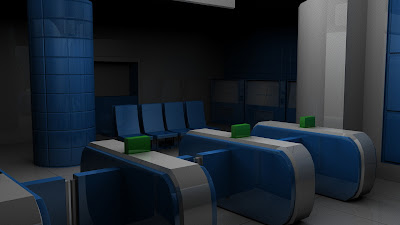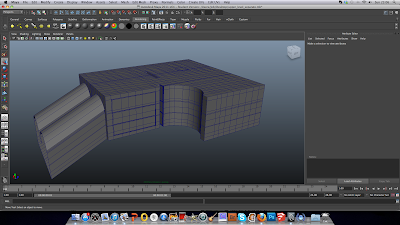To light my environment I looked at various tutorials on how to get objects to 'emit' light. During my research I actually discovered there are many different ways that actually all have totally different looks.
The first I discovered was attaching a surface light to a mia_material_x and adjusting the intensity through hyper shade and mental ray settings. However, with that method of lighting it made a strange 'watery' type look to the shadows of my scene when rendered. I even adjusted the final gather settings in mental ray, but couldn't seem to shift it.
Secondly I discovered using the 'glow' setting. This is very simple method but actually does not 'generate' light. It makes it appear that it's glowing, but it has no real effect on the surrounding environment.
For part of my environment I made additional floor lights to add subtle illumination to the curvature of a wall. I then selected the faces I wanted to 'glow' on the objects and assigned the material 'blinn'.
I
n the material
attributes under 'Special Effects' I adjusted the intensity according to
how I wanted the light to glow. After some test renders, I was relatively pleased with the effect but I wanted actual light to reflect off the curved wall and along the ceiling.
I then decided to add small 'spotlights' to the floor lamps. In doing this I will be able to give off the effect that the lights are 'glowing' and also actually have set lights illuminating the surrounding surfaces. I had to play with the intensity, cone angle and drop off settings to get the right kind of look. Anything to high in settings created a really sharp edge, so playing with these settings enabled me to get a nice soft look.
I applied the same glow technique on my decorative wall panel lights. However, instead of using a spot light I used a low intensity area light with a blue tint. This would then give off the same illusion that the panels are emitting light.
I also copied the technique to that of the ticket vendor screens. However, in this circumstance just a glowing material would be enough. All I want is for the screens to appear 'on' but I didn't want them to project any serious light into the room.
Within the inner tunnels of my escalator area, I added 8 spotlights. This was done to convey the lighting hidden in the edging of the ceiling. This type of light would be able to not only illuminate the tunnel but also accentuate the curvature of the roof. I also had to adjust the cone angle and drop off settings, so that the light was soft but intense enough to illuminate the area well. After making my mock up 2D painting in Photoshop at the beginning of this project, it was really nice to finally make them come to life in 3D.
With most of my lights set in place, I then had to find a light that would illuminate the room effectively. Previously I discovered that using a large area light would not be sufficient for this particular task. I went through each type of light until I came across the 'point' light which seemed to work perfectly. I wanted the light to act like a large cieling bulb, but not too intense so it wouldn't take away the purposes of surrounding lights.
I adjusted the intensity of the light until I found a good balance. I also set the Raytracing shadows to 3, so the light would cast some nice effects.
One thing I never really knew how to do in Maya was to utilize the Sun light to create photo realistic effects. I looked up a few tutorials and actually found a really helpful video that showed me how to generate a realistic outdoor light. As an area of my environment has a large window, it seemed ideal to adopt this technique.
The tutorial is located here:
http://cgterminal.com/2012/01/01/maya-photorealistic-rendering-tutorial/
To make this type of effect I had to create an area light that covered the window size in my environment.
In the Attribute editor under 'Custom Shaders' I attached a mia_portal light to the area light. I then enabled Raytracing shadows for effect and adjusted the settings to 5.
I then added a Sun light and directed it just above the window but so that it was pointing through it.
To get this to work effectively I had to change the quality size of the render.
I also selected 'Global Illumination' and 'Final Gathering' in the 'Indirect lighting' tab under mental ray settings. I made the accuracy of my global illumination set to 500 and my final gathering set to 500 also. I then increased both the point density to 1.5 and the point interpolation to 65. What this does is makes it so the sun and mia light portal work together to create a photo realistic effect. However, point interpolation and other settings such as FG and GI need to be adjusted in order to express the information correctly.
Here was my first 'positive' render using a total of 17 different types of light. Although I really love the realism of this render. I didn't like how hazy everything looked. Also the spotlight intensity from my floor lamps needed to be reduce, as the rays on the ceiling are far too strong.
I adjusted the settings again and decreased the intensity of both the glowing lamps and even the point light in the center of the room. I think this render turned out a lot nicer, simply because the light and shadow is complimenting it so well. In the previous render the intensity of the light was washing out the colour and masking some of the textures. Adjusting those settings and playing with test renders enabled me to identify the problems. In the render above the light is just right to not only express the boldness of the blue, but also accentuate the surface texture and materials.
I think this light set up is perfect for my positive variant of lighting. Every light has come together to bring out all the unique features of my environment. The colours, texures and futuristic theme are all beautifully emphasized through the diverse use of light. I am incredibly pleased with that outcome. Even though adjusting settings and making test renders took a considerable amount of time, it was most definitely worth the patience in the end. Now I am confident to go and create my negative lighting variant.






















































